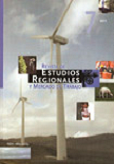El empleo rural en Santa Cruz: situación de coyuntura o crisis estructural
Main Article Content
Abstract
The socio-economical characterization of Santa Cruz Province, within the regional sub-system of Southern Patagonia, stands out the economical areas which are part of their production structures as well as how they adapt to the economic changes of the region, particularly as from the restructuration of the 80’s. Their main sectors, according to a descriptive type and based on how they developed through time, have given way to two big groups: “traditional” and “emerging” ones. The first and most important one being the farming sector, mainly represented by the sheep ranging activity.
The evolution of this activity reveals three different periods: an initial one, of development and prosperity of the sheep race (1880-1940), a second one of stability (1949-1980) and a third one of fall and crisis (1980-2001), being their most difficult years between 1994 and 2000. The population of Santa Cruz province has been strongly related to sheep activity which origin goes back to 1890, together with different migration currents highly sustained by a national policy of territorial occupation. The evolution of rural employment has been present in the province in each period. That is how it grew and stabilized significantly in the years of population, reaffirmed and had an abrupt fall as crisis started.
This crisis caused, among other things, the abandonment of farm facilities, diversity of employment for producers who had to focus on non-farming-related activities as an alternative or complementary source of income and, as a result of this, a strong decreasing of occupied rural manpower, when time of splendor and according to national and provincial census, more than a 50% of the province labor force used to work in different farming activities. As from year 2002, and induced by the convertibility regime outcome, Exploitation profitability is substantially modified to give way to a slow stability, although in a very different scenario, if compared with previous years. Despite the sustained demand with price increase and best economical results, the loss of traditional sheep culture, the characteristics of historical production systems and the outcome of other economic activities outside farming have caused the emigration of rural labor offer towards the urban areas, allowing us to approach a problem that extends from a key factor to a structural one.
Downloads
Article Details

This work is licensed under a Creative Commons Attribution-NonCommercial-ShareAlike 4.0 International License.
This work is licensed under a Creative Commons Attribution 4.0 International (https://creativecommons.org/licenses/by-nc-sa/4.0/deed.es).
